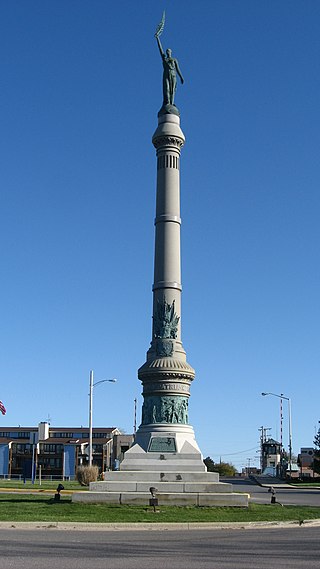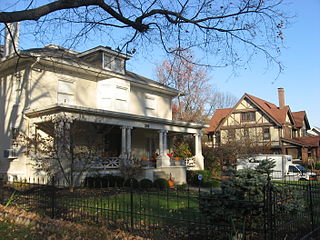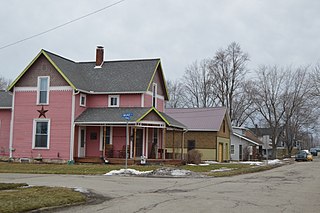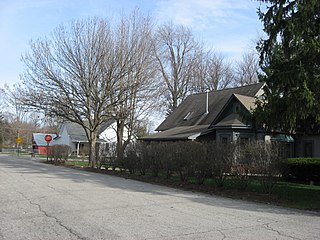
Fletcher Place is a historic district and neighborhood in the city of Indianapolis, Indiana named after Calvin Fletcher, a prominent local banker, farmer and state senator.

Chatham–Arch is a neighborhood located immediately east of Downtown Indianapolis, Indiana, United States. This neighborhood is one of the oldest in Indianapolis, dating back to the mid 19th century. Chatham–Arch contains many of Indianapolis's historic homes.

Bankers Row Historic District is a national historic district located at Logansport, Cass County, Indiana. The district encompasses 20 contributing houses in a residential section of Logansport. It developed between about 1875 and 1925 and includes notable examples of Queen Anne and Italianate style architecture. Bankers Row gains significance because it is associated with the growth and development of Logansport. The town gained commercial success in 1840 with the Wabash & Erie Canal, and then in the 1850s, when the first railroad came through town. The name "Bankers Row" was given to these homes by locals in the 1960s because of its association in the earlier part of the century, with men in the field of finance and banking.

Greenfield Courthouse Square Historic District is a national historic district located at Greenfield, Hancock County, Indiana, United States. The district encompasses 72 contributing buildings and 1 contributing object in the central business district of Greenfield that developed between about 1835 and 1935. The focal point of the district is the Romanesque Revival style Hancock County Courthouse (1896–1897) and Second Empire style jail. Other notable buildings are the Riley School, A.J. Banks Building / Morgan Building (1869), Randall Block, Christian Church (1895), Bradley Methodist Church (1902), First Presbyterian Church (1906–1907), Carnegie Library (1908–1909), Andrew Jackson Banks House, D.H. Goble House, and Walpole House.

Francis H. Morrison House is a historic home located at LaPorte, LaPorte County, Indiana. It was built in 1904, and is a 2+1⁄2-story, frame dwelling in an eclectic combination of popular revival styles including Tudor Revival, Gothic Revival, Classical Revival, and American Craftsman. It has a hipped roof with dormers, a two-story sleeping porch, Palladian window, and stuccoed areas with curved corner pieces.

Franklin Street Commercial Historic District is a national historic district located at Michigan City, LaPorte County, Indiana. The district encompasses 73 contributing buildings and 1 contributing object in the central business district and surrounding residential section of Michigan City. It developed between about 1875 and 1955, and includes examples of Italianate, Gothic Revival, Queen Anne, Classical Revival, and Tudor Revival style architecture. Located in the district is the separately listed Michigan City Post Office (1909-1910). Other notable buildings include the Staiger House, Earl House, M & M Diner (1955), Zorn Building (1907), St. Paul's Lutheran Church (1876) and rectory (1888), First Federal Savings Bank, Aicher Block (1914), Brinkman Building, Trinity Episcopal Church (1889), Merchants National Bank Building (1926), Ledbetter Building (1908), Rodenbeck Saloon, First Methodist Episcopal Church (1922), Barker Hall (1929), Masonic Temple (1922-1923), and the Salvation Army Building (1925).

Elston Grove Historic District is a national historic district located at Michigan City, LaPorte County, Indiana. The district encompasses 215 contributing buildings and 1 contributing structure in a predominantly residential section of Michigan City. It developed between about 1860 and 1963, and includes examples of Italianate, Greek Revival, Queen Anne, Colonial Revival, and Bungalow / American Craftsman style architecture. Notable buildings include the A.J. Henry House, Kubik Doctors Office (1953), Manny House (1902), Haskell-Boyd House, Moritz House (1911), Zorn Brewey, Petti Grocery, Luchtman Building, Dr. Ginther House (1940), Sherman Apartment Building (1921), First Baptist Church (1914), the Public Library (1896-1897), and the Adventist Church - Christian Science Church.

Haskell and Barker Historic District is a national historic district located at Michigan City, LaPorte County, Indiana. The district encompasses 205 contributing buildings, 3 contributing structures, and 1 contributing object in a predominantly residential section of Michigan City. The district is named for the Haskell and Barker manufacturing company. It developed between about 1860 and 1960, and includes examples of Italianate, Gothic Revival, Queen Anne, Colonial Revival, Tudor Revival, and Bungalow / American Craftsman style architecture. Located in the district are the separately listed John H. Barker Mansion and First Congregational Church of Michigan City. Other notable buildings include the St. Stanislaus Koska Church (1922-1926), Rectory (1938), and Convent (1938), Consumer Service Company (1922), Michigan City School of Fine Arts (1908), Gilmore-Gardner Building (1925), Porter-Carrigan House (1895), Hutchinson House (1875), St Mary of the Immaculate Conception Catholic Church (1868) and Convent (1905), and Hartke House.

Downtown LaPorte Historic District is a national historic district located at LaPorte, LaPorte County, Indiana. The district encompasses 70 contributing buildings in the central business district of LaPorte. It developed between about 1860 and 1930, and includes examples of Queen Anne, Romanesque Revival, and Neoclassical style architecture. Notable buildings include the Zahrt Blocks, Ridgway Hotel (1863), Higday and Collins Blocks (1886–1888), LaPorte County Courthouse (1890–1894), Odd Fellows Building (1895), Lonn's Block (1889), People's Bank (1912), U.S. Post Office (1912), New York Central Depot (1909), Masonic Temple (1910), and Hotel Rumely (1912).

Washington Park is a historic public park and national historic district located on Lake Michigan at Michigan City, LaPorte County, Indiana. The park encompasses 13 contributing buildings, 3 contributing sites, 11 contributing structures, and 21 contributing objects, and includes the Michigan City Zoo. It was established in 1891 and later developed by the Works Progress Administration and its predecessors during the 1930s. Notable features include the Soldiers' and Sailors' Monument (1896), former park headquarters building (1934), bandstand (1911), World War I doughboy monument (1926), tennis court, log picnic shelter, and four-story observation tower (1936).

Plymouth Downtown Historic District is a national historic district located in Plymouth, Marshall County, Indiana, United States. The district encompasses 47 contributing buildings and one contributing structure in the central business district of Plymouth. It developed between about 1870 and 1940, and includes examples of Italianate, Romanesque Revival, and Colonial Revival style architecture. Located in the district is the separately listed Plymouth Fire Station. Other notable buildings include the Montgomery Ward Building (1929), Metsker Block, Rentschler Building (1910), Early Plymouth Post Office (1884), First National Bank-Plymouth City Hall, Packard Bank Block (1879), Simons Building (1895), Wheeler Block, Bank Block, Bank Block-Masonic Temple (1901), Plymouth Post Office (1935), and Plymouth Motor Sales (1929).

Bloomington West Side Historic District is a national historic district located at Bloomington, Monroe County, Indiana. The district encompasses 394 contributing buildings, 2 contributing sites, and 2 contributing structures in a mixed residential, commercial, and industrial section of Bloomington. It developed between about 1850 and 1946, and includes notable examples of Queen Anne and Bungalow/American Craftsman style architecture. Located in the district are the separately listed Elias Abel House, Cantol Wax Company Building, Coca-Cola Bottling Plant, Cochran-Helton-Lindley House, Illinois Central Railroad Freight Depot, Johnson's Creamery, and Second Baptist Church. Other notable contributing resources include the Works Progress Administration constructed wading pool, White Oak Cemetery, Ninth Street Park, Bloomington Wholesale Foods Warehouse, Bloomington Garage, Curry Buick, Banneker School, Bethel African Methodist Episcopal Church, and Bloomington Frosted Foods.

Ellettsville Downtown Historic District is a national historic district located at Ellettsville, Monroe County, Indiana. The district encompasses 50 contributing buildings in the central business district and surrounding residential sections of Ellettsville. It developed between about 1840 and 1953, and includes notable examples of Queen Anne, Early Commercial, Gothic Revival, and Bungalow/American Craftsman style architecture. Notable buildings include the Robert Stimson House, May Presley House, Bradford House, George W. Fletcher House, Wickens House (1909), Capt. Gilbert Perry House, I.O.O.F. Building, Town Hall (1927), Masonic Building (1895), Knights of Pythias Building, First United Methodist Church (1900), and First Baptist Church (1909).

Elston Grove Historic District is a national historic district located at Crawfordsville, Montgomery County, Indiana. The district encompasses 138 contributing buildings and 8 contributing structures in a predominantly residential section of Crawfordsville. It developed between about 1835 and 1935, and includes notable examples of Italianate, Queen Anne, and Colonial Revival style architecture. Located in the district are the separately listed Col. Isaac C. Elston House, Henry S. Lane House, and Gen. Lew Wallace Study. Other notable buildings include the Galey House (1848), Campbell House (1852), T.S. Scott House, Powers House (1862), Blair House, Hadley and Hornaday Houses (1878), Alfrey House (1885), Detchon House, Ashley House, Snyder House, and Voris House.

Paoli Historic District is a national historic district located at Paoli, Orange County, Indiana. The district encompasses 144 contributing buildings, 1 contributing site, 4 contributing structures, and 4 contributing objects in the central business district and surrounding residential sections of Paoli. It developed between about 1840 and 1940, and includes notable examples of Greek Revival, Italianate, and Queen Anne style architecture. Located in the district are the separately listed Thomas Newby Braxtan House and Orange County Courthouse. Other notable contributing resources include Lithia Springs Park, Dr. J.H. Sherrod House (1885), Gabbert House, Lithia Water Bottling Plant (1920), Orange County Jail (1858), U.S. Post Office (1937), Presbyterian Church (1920), Methodist Episcopal Church (1888), Braxtan Store, Riley Building (1887), Paoli State Bank (1912), and Thomas Volney Thornton House (1846).

West Washington Historic District is a national historic district located at South Bend, St. Joseph County, Indiana. It encompasses 330 contributing buildings in an upper class residential section of South Bend. It developed between about 1854 and 1910, and includes notable examples of Italianate, Greek Revival, and Romanesque Revival style architecture. Located in the district are the separately listed Morey-Lampert House, Oliver Mansion designed by Lamb and Rich, Second St. Joseph County Courthouse, South Bend Remedy Company Building, and Tippecanoe Place. Other notable buildings include the Bartlett House (1850), Birdsell House (1897), DeRhodes House designed by Frank Lloyd Wright, Holley House, Kaiser-Schmidt House, Listenberger-Nemeth House, Meahger-Daughterty House (1884), O'Brien House, Oren House, The People's Church (1889), St. Hedwig's Church, St. Patrick's Church (1886), St. Paul's Memorial United Methodist Church (1901), West House, and a row of worker's houses.

West LaSalle Avenue Historic District is a national historic district located at South Bend, St. Joseph County, Indiana. It encompasses 33 contributing buildings and 2 contributing structures in a predominantly residential section of South Bend. It developed between about 1870 and 1930, and includes notable examples of Italianate, Queen Anne, Late Gothic Revival, and Beaux-Arts style architecture and works by architects Austin & Shambleau. Notable buildings include the St. Peter's Church (1927), Frank Eby House (1904), Lydia Klinger House (1900), Woodworth House, Woolman House (1880), Goetz House (1892), Studebaker House, Kuppler House (1885), and the Gunderman House.

Ellsworth Historic District, also known as Ellsworth Addition, is a national historic district located at Lafayette, Tippecanoe County, Indiana. The district encompasses 144 contributing buildings, 1 contributing site, and 4 contributing structures in a predominantly residential section of Lafayette. It developed between about 1844 and 1936 and includes representative examples of Italianate, Second Empire, Queen Anne, and Bungalow / American Craftsman style architecture. Located in the district are the separately listed Falley Home, Moses Fowler House, and Temple Israel. Other notable buildings include the Second Presbyterian Church (1894-1895), Alexander House, Ball Brothers House, Falley Townhouse, Home Block, Annie Fowler House, and Duplex Townhouse.

LaFontaine Historic District is a national historic district located at La Fontaine, Wabash County, Indiana. It encompasses 56 contributing buildings and 4 contributing structures in the central business district and surrounding residential sections of La Fontaine. It developed between about 1848 and 1930, and includes representative examples of Gothic Revival, Italianate, Queen Anne, Romanesque Revival, Classical Revival, and Bungalow / American Craftsman style architecture.

New Augusta Historic District is a national historic district located at Indianapolis, Indiana. It encompasses 114 contributing buildings, 1 contributing structure, and 1 contributing object in a railroad oriented village in Indianapolis. The district developed between about 1852 and 1939, and includes representative examples of Italianate and Bungalow / American Craftsman style architecture. Notable contributing buildings include the Odd Fellows Building, Hopewell Evangelical Lutheran Church, Salem Lutheran Church (1880), and New Augusta Depot. It is located west of Augusta.
























